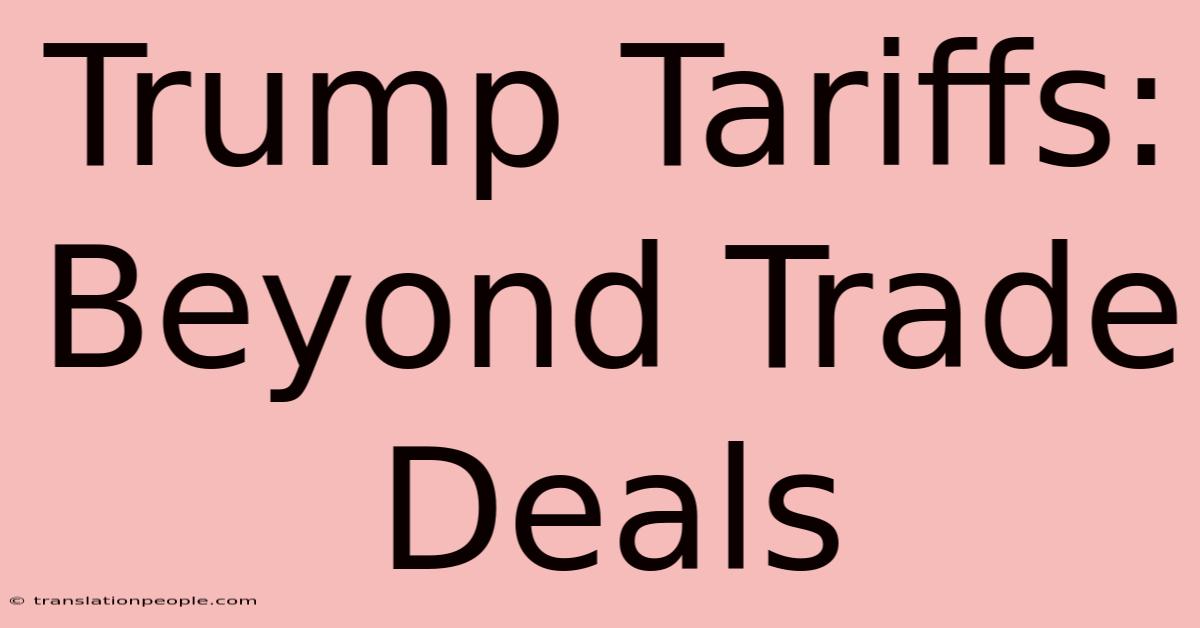Trump Tariffs: Beyond Trade Deals

Discover more detailed and exciting information on our website. Click the link below to start your adventure: Visit Best Website nimila.me. Don't miss out!
Table of Contents
Trump Tariffs: Beyond the Trade Deals – A Deeper Dive
Editor’s Note: The lasting impact of the Trump-era tariffs continues to unfold, extending far beyond initial trade negotiations. This article explores the multifaceted consequences.
Why This Matters
The Trump administration's imposition of tariffs on various goods wasn't simply a trade negotiation tactic; it sent ripples through the global economy and continues to shape economic policy today. Understanding the broader impact – beyond the headline-grabbing trade deals – is crucial for comprehending current economic trends and future policy decisions. This article will examine the long-term effects on industries, consumers, and international relations. We'll explore how these tariffs influenced inflation, supply chains, and the overall geopolitical landscape.
Key Takeaways
| Impact Area | Key Takeaway |
|---|---|
| Inflation | Tariffs contributed to increased consumer prices. |
| Supply Chains | Disrupted global supply chains, leading to shortages and higher costs. |
| Domestic Industries | Mixed results; some benefited, others suffered from increased input costs. |
| International Relations | Strained relationships with key trading partners. |
Trump Tariffs: A Deeper Dive
The imposition of tariffs, particularly on steel and aluminum, under the guise of national security, wasn't just about trade deals. It represented a significant shift in global trade relations, prompting retaliatory measures from other countries and creating a complex web of economic consequences.
Key Aspects:
- National Security Justification: The use of national security as a justification for tariffs broadened the scope of protectionist measures beyond traditional trade arguments.
- Retaliatory Tariffs: The tariffs sparked a global trade war, with other countries implementing their own tariffs on US goods.
- Impact on Specific Industries: Industries like agriculture and manufacturing experienced varying degrees of impact, some facing increased costs, others potentially gaining a temporary competitive advantage.
Detailed Analysis:
The initial aim was to protect domestic industries, particularly steel and aluminum producers, from foreign competition. While some US producers experienced short-term benefits, the increased costs of imported raw materials significantly impacted downstream industries. For example, higher steel prices affected the automotive sector, increasing production costs and potentially leading to job losses in the long run. The retaliatory tariffs imposed by other countries also hurt US exporters, particularly in agriculture. The net effect on job creation remains a subject of ongoing debate.
Inflationary Pressures
The tariffs contributed significantly to inflationary pressures. Increased costs of imported goods were passed on to consumers, leading to higher prices for a range of products. This inflationary effect further exacerbated existing economic challenges and contributed to the overall economic uncertainty.
Disrupted Supply Chains
The trade war disrupted established global supply chains. Companies faced difficulties sourcing raw materials and intermediate goods, leading to production delays and shortages. This highlighted the interconnectedness of global trade and the vulnerability of supply chains to geopolitical events.
People Also Ask (NLP-Friendly Answers)
Q1: What are Trump tariffs?
A: Trump tariffs refer to the tariffs and trade restrictions imposed by the Trump administration on various goods from several countries, often citing national security or unfair trade practices as justification.
Q2: Why were Trump tariffs implemented?
A: The stated reasons varied, but they often included protecting domestic industries from foreign competition, addressing what the administration perceived as unfair trade practices, and enhancing national security.
Q3: How did Trump tariffs affect consumers?
A: Trump tariffs generally led to higher prices for consumers due to increased costs for imported goods and the impact on supply chains.
Q4: What were the international consequences of Trump tariffs?
A: Trump tariffs triggered retaliatory tariffs from other countries, escalating trade tensions and harming global trade relations.
Q5: How did Trump tariffs impact specific industries?
A: The impact varied greatly. Some industries benefited from protection, while others suffered from higher input costs and reduced competitiveness.
Practical Tips for Navigating Post-Tariff Economic Landscape
Introduction: Understanding the lingering effects of the Trump tariffs is crucial for businesses and consumers alike. These tips can help you navigate the evolving economic environment.
Tips:
- Diversify Supply Chains: Reduce reliance on single-source suppliers to mitigate future disruptions.
- Monitor Trade Policy: Stay informed about changes in trade regulations and their potential impact.
- Analyze Cost Structures: Assess the impact of tariff changes on input costs and pricing strategies.
- Explore Alternative Markets: Identify new sourcing options and export markets to reduce reliance on affected regions.
- Invest in Technology: Automation and efficiency improvements can offset increased production costs.
- Seek Government Support: Investigate available programs and resources to mitigate the negative effects of tariffs.
- Negotiate with Suppliers: Work closely with suppliers to manage costs and maintain supply chain stability.
- Adapt Pricing Strategies: Adjust pricing to reflect changes in input costs while maintaining competitiveness.
Summary: The Trump tariffs represent a complex and multifaceted issue with lasting implications. Their impact extends far beyond initial trade deals, affecting inflation, supply chains, and international relations. Adapting to the post-tariff economic landscape requires a proactive and strategic approach.
Call to Action: Stay informed about evolving trade policies by subscribing to our newsletter for regular updates and insightful analyses. Share this article with your network to raise awareness about the lasting impact of the Trump tariffs.
Hreflang Tags (Example - Adapt for all relevant languages):
<link rel="alternate" hreflang="en" href="https://yourwebsite.com/trump-tariffs" />
<link rel="alternate" hreflang="es" href="https://yourwebsite.com/trump-aranceles" />

Thank you for visiting our website wich cover about Trump Tariffs: Beyond Trade Deals. We hope the information provided has been useful to you. Feel free to contact us if you have any questions or need further assistance. See you next time and dont miss to bookmark.
Featured Posts
-
Preview Barcelona Takes On Brest
Nov 26, 2024
-
Scarlett Johansson Josts Naughty Side
Nov 26, 2024
-
Champions League Seedorfs Menu
Nov 26, 2024
-
Global Microsoft Outage Current Status
Nov 26, 2024
-
Winter Storm Threatens Thanksgiving
Nov 26, 2024
